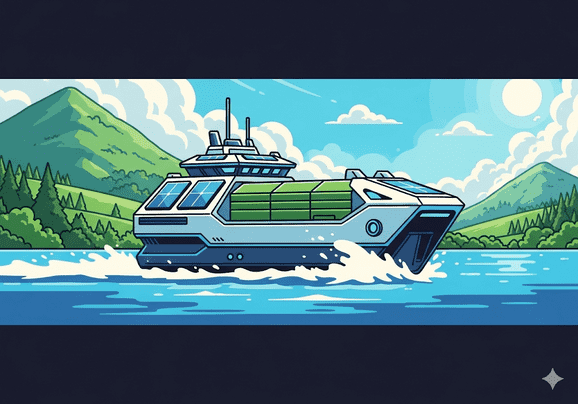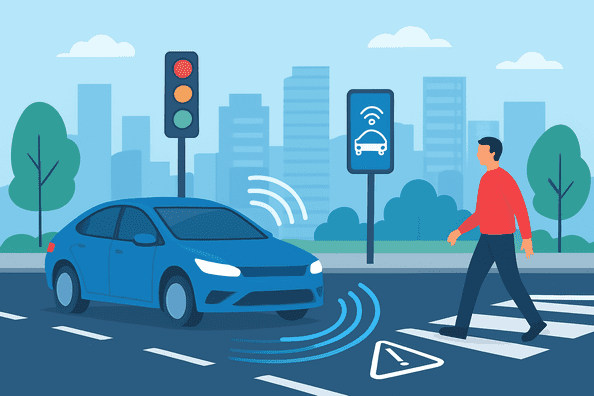Mythos AI is charting a new course for maritime logistics by blending autonomous navigation, digital twin mapping, and environmental stewardship. As global trade volumes surge and pressure mounts to decarbonize shipping, Mythos AI’s solutions offer a pragmatic path to safer, greener waterways. This article explores the company’s origins, technologies, real-life applications, sustainability impacts, economic benefits, regulatory challenges, and future outlook—providing an in-depth, human-centered understanding of how Mythos AI is transforming maritime shipping.
Navigating the Imperative for Autonomous Shipping
The global shipping industry moves over 80% of world trade by volume but is responsible for roughly 3% of carbon emissions globally. Many vessels still rely on manual navigation practices, paper charts, and infrequent hydrographic updates that become outdated rapidly. These limitations lead to costly incidents like groundings, inefficient routing that wastes fuel, and safety risks in busy harbors or narrow inland passages.
Adding further pressure is tightening environmental regulation. The International Maritime Organization (IMO) has introduced strategies targeting significant greenhouse gas reductions by 2050. Regionally, the European Union’s Fit for 55 package forces shipping to align with ambitious emission-cutting goals. The industry faces urgent demands to optimize fuel consumption, enhance safety, and reduce operational footprints.
In this context, autonomous technologies emerge as critical enablers. Continuous seabed mapping, real-time hazard detection, and AI-augmented navigation promise more efficient, safer, and sustainable maritime routes when integrated into existing infrastructure and workflows.
Mythos AI’s Genesis and Vision
Mythos AI was founded in 2020 by a team of engineers with backgrounds in self-driving cars and marine surveying who saw an opportunity to apply automotive autonomy breakthroughs to shipping. Their goal is to create a new paradigm for waterways management through three strategic pillars:
First, high-resolution hydrography through autonomous vessels that continuously map ports and channels. This real-time depth data powers better operational decisions and reduces risks from sediment shifts or uncharted hazards.
Second, advanced pilot assistance systems that serve as AI copilots, providing crews with situational awareness, optimized fuel profiles, and navigation alerts compliant with maritime “rules of the road” called COLREGs.
Third, to build decentralized marine highways—small, autonomous vessels moving cargo on inland rivers and coastal routes—relieving coastal congestion, lowering emissions, and improving supply chain resilience.
This vision blends innovation with pragmatism, emphasizing stepwise adoption where human expertise and AI augmentation grow stronger together.
Core Technologies Powering Mythos AI
At the core of Mythos AI’s offerings are three integrated technologies designed to improve safety, efficiency, and environmental sustainability.
Archie: Autonomous Survey Vessel
The Archimedes-class vessel, known as Archie, is equipped with industry-leading multibeam sonar, LiDAR, and radar sensors. It can operate autonomously for up to 72 hours, performing high-fidelity bathymetric surveys that replace months-old charts with fresh data. These surveys help ports stay ahead of sediment buildup and changing seabeds, critical for preventing groundings and optimizing draft limits.
Thanks to onboard edge computing, Archie processes sonar returns and detects hazards during missions. Survey data is then uploaded to the cloud, where it feeds digital twin platforms empowering ports with constantly updated environmental and navigational intelligence. Archie’s intuitive interface requires minimal operator training—maritime teams simply select survey areas, and the vessel executes precise, automatic coverage.
Digital Twin Platform
Mythos AI’s digital twin platform integrates continuous hydrographic surveys alongside AIS traffic data, weather forecasts, and vessel telemetry. This creates a living model of waterways with several distinct advantages.
Among them is predictive dredging: sediment drift projections enable ports to schedule targeted maintenance before navigational channels become unsafe. Traffic simulations test berth utilization and vessel passages under various conditions, reducing congestion and wait times. Environmental overlays steer vessels clear of sensitive habitats, supporting marine biodiversity while enabling compliance with regulations.
Ports and operators access these digital twins via interactive dashboards that provide real-time alerts and scenario planning tools, enhancing decision-making across supply chains.
Advanced Pilot Assist System (APAS)
The Advanced Pilot Assist System (APAS) is an AI-based shipboard aid that complements human navigation. Integrating radar-first perception protocols, APAS processes multiple data streams to reduce crew workload and distractions by delivering clear hazard alerts.
The system detects floating debris, small craft, and uncharted obstacles even in adverse weather or poor visibility. It advises fuel-efficient speed and heading adjustments, leveraging currents to minimize engine load and emissions. Importantly, APAS is designed to comply with COLREGs, ensuring its maneuvers conform to international collision prevention rules.
APAS is intended as a decision-support tool rather than a replacement. It learns over time from operator corrections, adapting guidance based on local waterways and vessel characteristics.
Real-World Pilots and Partnerships
Mythos AI’s innovations have been piloted extensively in collaboration with key maritime partners, resulting in tangible operational and environmental gains.
At the Port of Monroe, an eight-week trial supported by Newlab and Michigan Central saw Archie autonomously surveying berths and anchorages along a critical Great Lakes corridor. The resulting digital twin improved berth scheduling by 25% and minimized vessel idle time, producing measurable efficiency gains. This success established Monroe as a living lab for autonomous maritime logistics and set the stage for future deployments of self-driving ferries and cargo skiffs.
Interlake Steamship Company, operating on the Great Lakes, integrated Archie permanently for routine bathymetric surveys. The autonomous vessel cut survey durations by 60% compared to traditional crewed operations. More accurate depth data allowed ships to reduce ballast voyages by 15%, in turn lowering fuel consumption and emissions.
Meanwhile, the Southern Devall towboat, operating on the Mississippi River, was among the first vessels outfitted with APAS. Over three months, the vessel recorded a 15% drop in navigation-related incidents, and fuel consumption dropped by 12%, owing to AI-guided speed optimization. Crew feedback highlighted enhanced situational awareness, particularly beneficial in tight river bends and congested port approaches.
Recently, Mythos AI joined forces with lomarLabs, the innovation arm of Lomar Shipping, to test APAS and Archie-enabled vessels on coastal dry bulk carriers. This partnership validated the company’s prowess in navigating COLREGs-compliant autonomous operations under complex coastal traffic and contributed new data to enhance system performance industry-wide.
Table: Summary of Mythos AI Pilots and Benefits
| Pilot Location | Technology Deployed | Operational Benefit | Environmental Impact |
|---|---|---|---|
| Port of Monroe (Great Lakes) | Archie Autonomous Survey Vessel | 25% reduction in vessel idle time | Lower emissions from less idling |
| Interlake Steamship (Great Lakes) | Archie Autonomous Survey Vessel | 60% faster survey completion | 15% fewer ballast voyages |
| Mississippi River Towboat | Advanced Pilot Assist System (APAS) | 15% fewer navigation incidents | 12% reduction in fuel consumption |
| Coastal Dry Bulk Carriers | Combination of Archie and APAS | Verified COLREGs-compliant autonomy | Data supports global emission cuts |
Sustainability and Environmental Impact
The environmental advantages of Mythos AI’s offerings are multifaceted. By enabling real-time seabed data and dynamic route optimization, the company significantly reduces fuel waste inherent in conventional marine navigation. Idling vessels, often stuck awaiting berth availability, contribute heavily to emissions—reducing this idle time by even a quarter yields meaningful carbon savings.
Bathymetric precision also supports targeted dredging operations. By proactively surveying channels daily or weekly, ports prevent dangerous sediment accumulation that can force ships to lighten loads or take longer alternative routes. This focused dredging approach reduces environmental disturbances to marine habitats compared to blanket dredging.
The emerging use of decentralized marine highways, where smaller autonomous vessels utilize inland waterways, enables more efficient cargo distribution, easing the burden on congested major ports. These routes produce lower emissions than deep-sea freight for short-haul connections, delivering holistic supply chain greening.
In addition to emissions reduction, Mythos AI’s platform supports marine conservation by integrating protected area overlays and seasonal habitat maps. This facilitates route planning that consciously avoids critical breeding grounds or fragile ecosystems, making sustainable maritime logistics not just possible but practical.
Economic Benefits and Return on Investment (ROI)
Mythos AI’s technologies drive strong financial benefits for stakeholders including ports, shipowners, and logistics providers. Autonomous vessels like Archie deliver hydrographic surveys at approximately 30–50% of the cost of traditional crewed operations while providing fresher, higher-resolution data. Optimized vessel loading and routing reduce bunker consumption by up to 12%, offering considerable fuel savings.
For port operators, improved berth scheduling and traffic simulation translate into faster turnaround times and higher throughput without costly infrastructure expansion. The digital twin platform drives data-centric decision-making that mitigates costly groundings, delays, and insurance claims.
On the revenue side, ports and maritime service providers can monetize analytics through subscription models, while insurers may reward operators demonstrating APAS-enabled safety improvements with lower premiums.
While initial investment in sensors, computing, and communications infrastructure can be material, case studies show payback periods under two years in busy waterways. Retrofitting current vessels rather than building new ones accelerates adoption and reduces upfront costs.
Regulatory and Safety Considerations
The maritime sector is governed by complex regulations, and autonomous technologies must align with these frameworks. Mythos AI’s phased approach to autonomy follows IMO’s voluntary guidelines on Marine Autonomous Surface Ships (MASS), focusing initially on AI systems that augment rather than replace human crews. This enhances safety and regulatory acceptance.
Given the increasing connectivity of vessels, cybersecurity remains paramount. Mythos AI protects data through end-to-end encryption, zero-trust networks, and proactive vulnerability assessments. These measures ensure operational reliability and protect commercially sensitive data.
Equally important is the human factor. Mythos AI provides comprehensive training for crews to understand, trust, and effectively work alongside autonomous systems. This collaboration lowers resistance, maintains manual skills, and ensures safe decision-making standards.
Challenges and Limitations
Adoption of autonomous shipping technologies faces several challenges. Infrastructure in many ports and inland waterways remains insufficient for real-time data exchange or autonomous mooring support. Regions vary in charting standards and data formats, complicating seamless integration and analytics.
Environmental factors such as extreme weather, fog, or storms still disrupt sensor operations and connectivity, creating operational uncertainty. Furthermore, current legal frameworks are ill-prepared to assign liability in AI-related incidents, requiring international policy innovation.
Despite these hurdles, Mythos AI continues to demonstrate that carefully managed, iterative deployments coupled with stakeholder engagement pave the way for widespread autonomous maritime operations.
Future Outlook and Trends
The future of maritime shipping points toward hybrid fleets blending crewed vessels with autonomous ones under unified traffic management systems. Advances in onboard AI processing will reduce dependence on external connectivity and improve real-time adaptability.
Global regulatory harmonization will unlock broad-scale adoption by simplifying compliance and data sharing. Meanwhile, coupling autonomy with emerging green propulsion technologies like hydrogen fuel cells promises near-zero-emission shipping globally.
Emerging autonomous applications will expand beyond cargo vessels, including offshore supply, environmental monitoring, and passenger ferries—underscoring the transformative potential of AI-enabled maritime operations.
Conclusion
Mythos AI is steering maritime logistics toward a future where autonomous technologies deliver safer, cleaner, and more efficient shipping routes. By integrating autonomous hydrography, AI-assisted navigation, and real-time digital twins, Mythos AI fosters a sustainable maritime sector that balances environmental stewardship with economic growth.
The company’s pilot projects illustrate how incremental adoption builds trust, optimizes performance, and meets pressing emissions targets today while laying the foundation for fully autonomous waterways tomorrow. For ports, shipowners, regulators, and environmental advocates alike, Mythos AI presents a compelling vision of decarbonized, resilient, and intelligent shipping.



